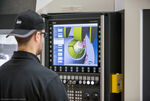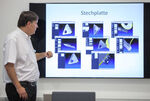15.12.2016
Grinding with 64-bit Architecture, or a 9 Billion Kilometer Journey to Work.

Haas Schleifmaschinen: Multigrind® Horizon.
Grinding with 64-bit Architecture
The Multigrind® Horizon grinding software from Haas Schleifmaschinen and the Siemens 840 SL controller on Haas grinding machines are designed for a 64-bit architecture. So it bears asking the question: what are the actual differences between a 32-bit and a 64-bit architecture? And what do the differences mean to users?
85,000 year journey to work
As a first step to understanding this complex topic, here is an analogy that illustrates the scope of a 64-bit architecture: If 32 bits represent a distance of two kilometers (or 2(32-1) µm), then 64 bits represent a distance of around nine billion kilometers (or 2(64-1) µm). Assuming you need around 20 minutes to walk the two kilometers to work (walking at a brisk pace), then you would need nearly 85,000 years for the nine billion kilometers.
But back to the beginning – to put it simply, as a result of their design, processors with a 64-bit architecture (word width) can process 64 bits (8 bytes) simultaneously during one clock cycle. This is like having four lanes on a highway instead of only two.

Haas Schleifmaschinen: Multigrind® CU - 3-D Schleifsimulation with 64-Bit-Modus.
Nearly Double the Throughput
Software applications that are designed for such a 64-bit architecture can address a maximum memory area (RAM or virtual memory) of 2(64-1) bits. This makes significantly more complex data structures possible. Applied to a graphical element, this would –theoretically – allow the same graphics to be produced with ten million times the detail.
Multigrind® Horizon Grinding Software Uses the Entire Installed Memory
The value 2(64-1) bits is equal to 9,223,372,036,854,775,808 bits (known as one exabyte (EB), or about a billion gigabytes (GB)). To illustrate the difference, the smartphone that you use everyday probably has one or two gigabytes of RAM and a storage capacity of 64 or 128 gigabytes. These are only theoretical values, of course – because what good does it do a conductor to be able to simultaneously conduct 2000 musicians when there are only five people in his orchestra? For Haas Schleifmaschinen, the 64-bit architecture means that the software uses the entire installed memory. By the way, popular 32-bit software applications can only simultaneously address a maximum memory area of 2(32-1) bits (2,147,483,648 bits). That’s only about two gigabytes!

Haas Schleifmaschinen: High complexe geometries.
Quickly Calculates Highly Complex Geometries
This comparison makes it clear – 64-bit means considerably more processing power and an even larger range, provided the hardware and software are designed to use it. When it comes to grinding and above all programming grinding processes, we work with extremely large quantities of data, which means that 64-bit mode makes calculating highly complex grinding geometries much faster. In addition, the graphical visualizations of 3D grinding simulations are significantly smoother in 64-bit mode – and offer more detail. As a result, even complex grinding paths can quickly be simulated and reviewed by the operator using the Multigrind® Horizon software packages. We asked Wolfram Hermle to explain the 64-bit architecture to us.

Haas Schleifmaschinen: Multigrind® Horizon - Modul insert.
Schleifblog: Mr. Hermle, when did you begin designing the Multigrind® Horizon grinding software for a 64-bit architecture?
Wolfram Hermle: Actually right from the beginning. At Haas Schleifmaschinen, compatibility is extremely important to us. We make a point of never using any exotic data structures that would make it more difficult to switch over to other data bandwidths.
Is Haas’s entire grinding software designed for 64-bit?
Nearly! We’re still working on compatibility with existing customers’ data structures, some of whom are still using data with a 32-bit or even 16-bit structure.
What effect does the 64-bit architecture have on Haas customers’ daily work?
In fact, the user shouldn’t consciously notice anything – except the fact that they don’t reach limits as quickly, that graphics and simulations are more detailed, and that everything can run a bit faster.
Are there certain grinding jobs that particularly benefit from 64-bit?
Up until now, users would often reach certain limits when processing complex structures, like those set forth as a CAD solid. Working on the “64-bit highway” should be a lot more fun in these cases.
What do you feel is more important, the grinding software or the mechanics of the grinding machine?
With our products, we operate in the real world. We have real workpieces, real tools, real processes, and as such, real machines. As long as we are operating in the real world, this question isn’t really valid. There is absolutely no doubt that both factors, the grinding software and the grinding machine, always need to meet the highest standards and “grow” with the challenges.
Do you remember how large the hard drive in your first computer was?
(Laughs) Hard drives were much too expensive. Floppy drives were the answer – today no one even knows what those are! I had two which had space for a whopping 364 kB. Which is a joke by today’s standards. We actually counted bytes to save space. Back then, one MB of space cost about five marks (2.56 euros), and they actually claimed the price would never go down. And back then, RAM was 1 MB. But that was a long time ago – 1.7 × 213days, to be precise.
Thank you for time, Mr. Hermle.




Comments (0)
Write a comment